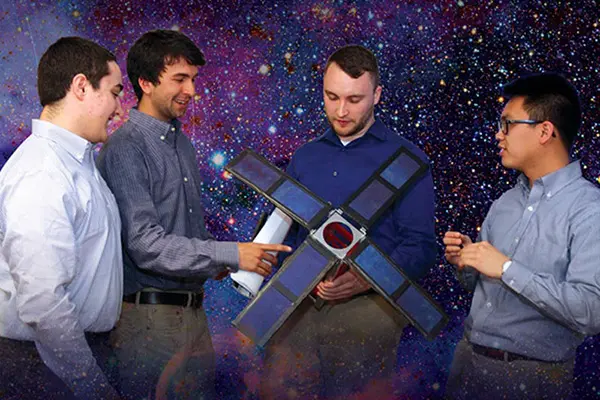
04/24/2017
Lowell Sun
By Prudence Brighton
LOWELL -- While thousands of scientists and engineers around the world spent Saturday on their feet at rallies to support scientific work, a smaller group spent the day at UMass Lowell charting a course for new feats in space exploration.
About 140 scientists, engineers, astronauts, NASA officials, space entrepreneurs, academics and students were on hand for a symposium marking the 60th anniversary of the Space Age. The event was a chance to reflect on the advances over six decades and to look ahead to the next decade and the years beyond.
The excitement was often palpable as speakers and panelists shared their passion for space exploration. Contributors and attendees came from across the globe.
"This is a great event," said Dr. Noureddine Melikechi, recently named dean of UML's Kennedy College of Sciences.
Asked about the rallies going on elsewhere in the country, including Boston, he said he did not have to choose. His wife and daughter went to Boston to represent him.
Retired Air Force Lt. Gen. James A. Abrahamson, who also served as the first director of the Strategic Defense Initiative and then as an associate administrator at NASA, looked back to the 1950s and the Soviet Union's success in launching a satellite, Sputnik, before the U.S did. "We lost the battle, but we didn't lose the war," he said.
Now chairman of the board of directors at the Center for the Advancement of Science in Space, Abrahamson said, "That loss was so important to us.
But our loss was also our gain." It propelled the nation forward to be the first to have a man walk on the moon.
"Now we have reached a tipping point of commercial activity. NASA knows how to do it. It cannot be stopped and no one wants it to," Abrahamson said. "Enlightened government initiatives and our competitive capitalist economy" will enable the space program to take off "in exactly this way."
He cited the "important transformation in enabling NASA to build things safely and successfully" as one of those government initiatives.
Rocketing ahead
Another speaker, Robert Cabana, who is director of the Kennedy Space Center, detailed the changes that have occurred at the Florida installation. Cabana, a retired astronaut and Marine colonel, has managed the conversion of the space center to a "multi-user spaceport."
Now SpaceX, Boeing, Lockheed Martin, and Blue Origin have facilities there. SpaceX is the brainchild of Elon Musk, founder of Tesla Motors, and Blue Origin is the creation of Jeff Bezos, founder of Amazon and owner of the Washington Post.
"There are more and more players in the space business," said John Connelly, NASA's Mars team leader. "Now you see activities by universities, private companies, and other countries involved."
NASA is employing a "step-wise exploration plan." That plan, Connelly said, uses the "von Braun paradigm." Named after the German American aerospace engineer Wernher von Braun, the plan was to begin with a shuttle, then a space station followed by missions to the Moon and Mars. The U.S. resequenced the plan during the Kennedy administration.
The plan now is to build a deep-space gateway near the Moon that can be used for further exploration of its surface or as a stepping stone to Mars. "The gateway is our platform for building a Mars vehicle."
NASA's timetable is for the gateway to be in place by the mid-2020s and missions orbiting Mars by 2033.
Connelly has no doubt that the U.S. will succeed. "We have the most competitive society and economy. We can generate the questions. We are an incubator of ideas, innovation and capitalism. There is something about this country that encourages openmindedness."
Ventures, adventures
The new players in space exploration were evident during an afternoon panel discussion.
Rahul Narayah, team leader at Axiom Research Labs in India, talked about the TeamIndus programs that will involve youth in his country's journey to the Moon. The Moonshot Cadets program will bring 15 students to the operations center on launch day. The Lab2Moon program selected eight teams, including one from the University of Illinois, to prepare experiments in exobiology (search for life on other planets) and sustainable technology for the flight.
The United Arab Emirates is operating on a 100-year plan for exploring space and colonizing Mars, according to Adnan Alrais of the Mohammed bin Rashid Space Center in Dubai. Thus far, the UAE has worked with South Korea and Japan in developing its space probe. Its young engineering team -- the average age is 27 of whom 40 percent are women -- is working on an unmanned mission to the red planet in 2021.
California-base Novawurks is moving from the realm of "science fiction to science fact" said Talbot Jaeger, a company representative. Novawurks is working on reconfigurable, technology building blocks for space travel. To a layperson, the blocks are reminiscent of interlocking pieces in a Lego set. These blocks, however, are packed with technology that can be used in many ways.
"It's exciting to be part of this world," Jaeger said. "It's about where can we go next, if we don't have to worry about what to bring."
UMass Lowell students had a chance to describe experiments and projects they are working on. Juniors Alex Casperson of Burlington, an electrical engineering major, and Eric Carey of Westford, a mechanical engineering major, talked about the project they are working on for NASA under a $200,000 grant the university received last year.
They are part of a team building a satellite for NASA, dubbed the Space Hauc, which will pioneer higher data-transmission rates than are currently possible. They are targeting a transmission rate that is 10 times greater than what is now available.
Their presentation drew the respect of those who attended. They received the top prize among the presenters who otherwise were graduate students and doctoral candidates.
